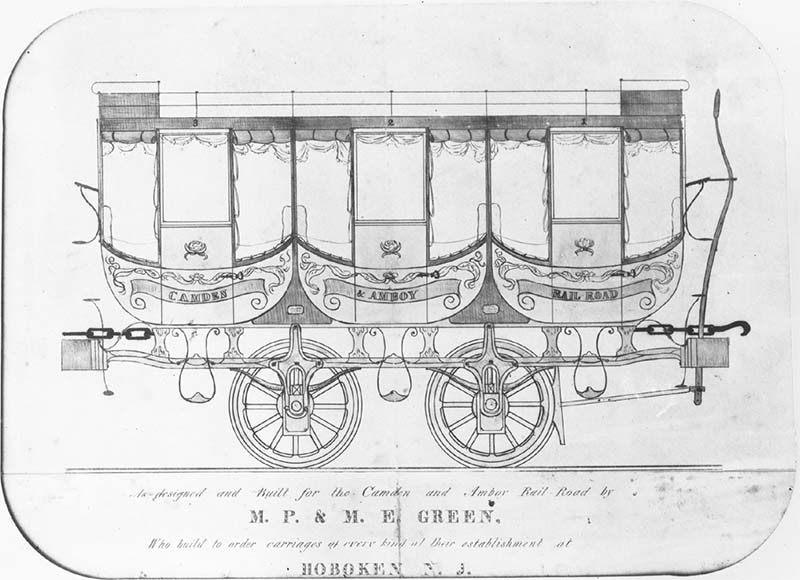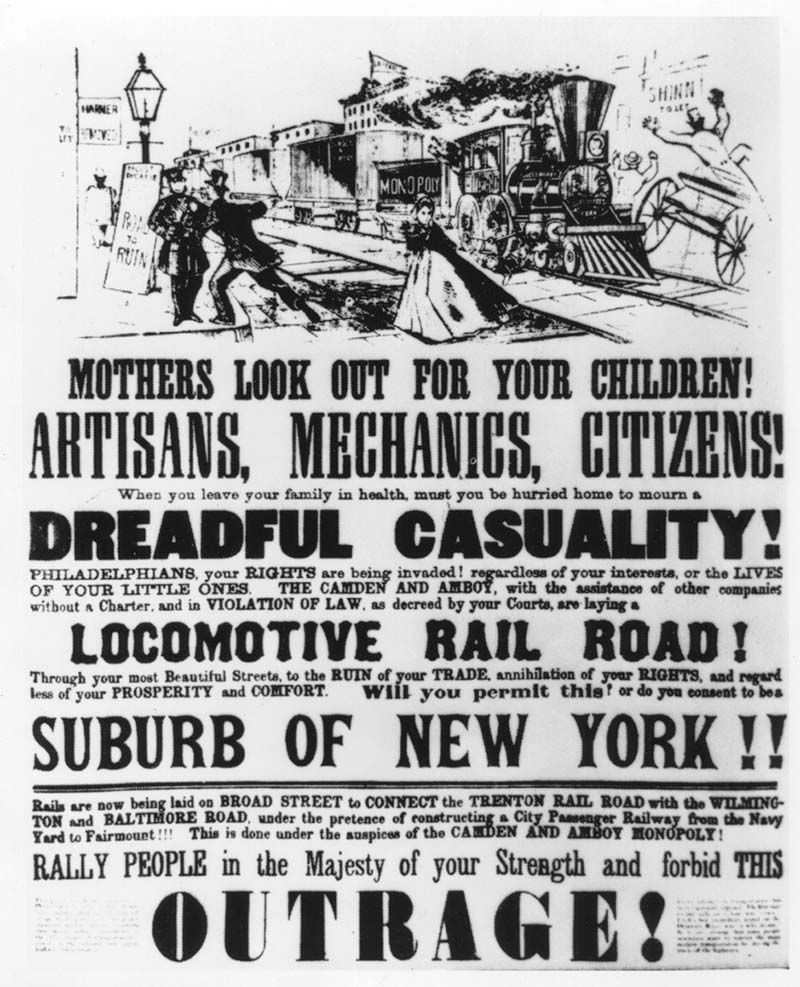America’s History: Printed Page 298
THINKING LIKE A HISTORIAN |  |
The Risks and Rewards of Technological Innovation
The nineteenth century was the Age of Progress, and improved transportation was one of its hallmarks. Between the 1830s and the 1860s, American capitalists and workers, aided by state governments, built steam-powered railroads that stretched across the nation and reduced the cost of moving goods and people by more than 90 percent. Yet, like all major technological changes, the railroad revolution was controversial, expensive, and politically explosive.
Speech by John B. Morris, a director of the Baltimore and Ohio Railroad, July 4, 1828, at the dedication of the first steam railway in the United States.
Fellow-Citizens. … We have met to celebrate the laying of the first stone of the Baltimore and Ohio Railroad. … The result of our labors will be felt, not only by ourselves, but also by posterity, — not only by Baltimore, but also by Maryland and by the United States. We are about opening the channel through which the commerce of the mighty country beyond the Alleghany must seek the [Atlantic] ocean. … We are in fact commencing a new era in our history; for there are none present who even doubt the beneficial influence which the intended Road will have in promoting the Agriculture, Manufactures and Inland Commerce of our country.
Illustration of a passenger car built by M. P. & M. E. Green of Hoboken, New Jersey, for the Camden and Amboy Railway, linking New York City and Philadelphia, 1831.
 Source: Division of Work & Industry, National Museum of American History, Smithsonian Institution.
Source: Division of Work & Industry, National Museum of American History, Smithsonian Institution.Poster protesting the laying of tracks through the “most Beautiful Streets” of Philadelphia, 1839.
 Source: National Archives.
Source: National Archives.Opposition to the state financing of railroads from the Republican Compiler, Gettysburg, Pennsylvania, October 6, 1851. As American track mileage grew from 3,000 miles in 1840 to 30,000 miles by 1860, entrepreneurs in Pennsylvania, assisted by the state legislature, led the nation in laying rail.
The Governor’s organ [newspaper] is still harping about the Governor having paid off the State debt, and reducing the taxes. If the taxes have been reduced, why is it that every farmer finds that he has paid MORE TAXES the last year than he has ever paid in a single year before? … The true issue is that Gov. Johnston and his friends created the [huge state] debt. …
The people remember that Gov. Johnston voted $405,000 to the Gettysburg railroad. …
They remember that he voted $150,000 to the Danville and Pottsville railroad.
They remember that he voted $140,000 to the Laughlintown and Pittsburg railroad, that never was incorporated.
They remember that he voted $120,000 to the Norristown railroad.
They remember that he voted for a bill appropriating over THREE MILLIONS OF DOLLARS to State and company improvements in one year, and that Gov. Ritner said that such appropriations would increase the State debt, in four years, to $45,000,000.
Lyrics to “The Waggoner’s Curse,” c. 1850.
Come all ye bold wagoners turn out man by man
That’s opposed to the railroad or any such a plan;
’Tis once I made money by driving my team
But the goods are now hauled on the railroad by steam. …
If we go to Philadelphia, inquiring for a load,
They’ll tell us quite directly it’s gone out on the railroad.
The rich folks, the plan they may justly admire,
But it ruins us poor wag’ners and it makes our taxes higher …
It ruins wheelwrights, blacksmiths, and every other trade,
So damned be all the railroads that ever was made.
It ruins our mechanics, what think you of it, then?
And it fills our country full of just a lot of great rich men.
The ships they will be coming with Irishmen by loads,
All with their picks and shovels, to work on the railroads;
When they get on the railroad, it is then that they are fixed
They’ll fight just like the devil with their cudgels and their sticks.
The American with safety can scarcely ever pass,
For they will blacken both his eyes for one word of his sass
If it wasn’t for the torment I as life would be in hell,
As upon the cursed railroad, or upon the canal.
Henry David Thoreau, Walden, or, Life in the Woods, 1854. The workers who built and ran the railroads suffered high rates of injury and death — facts noted by Henry David Thoreau, a critic of the market, transportation, and industrial revolutions of his day.
We do not ride on the railroad; it rides upon us. Did you ever think what those sleepers are that underlie the railroad? Each one is a man. … The rails are laid on them, and they are covered with sand, and the cars run smoothly over them … ; so that, if some have the pleasure of riding on a rail, others have the misfortune to be ridden upon.
Senator L. J. Rose, from Testimony Taken by the United States Pacific Railway Commission, 1887.
The railroads have made Southern California what it is to-day. Before the completion of the … Union and Central Pacific roads the southern half of California, which is now famous the world over as the most favored quarter in America in point of climate and soil conditions, was no more nor less than a barren sheep pasture. … Our redemption came in 1869, when the railroad people completed that gigantic and wonderful work … , giving California a direct rail connection with the East. The effect was marvelous and immediate. … We beheld ourselves in a day, as it were, surrounded by possibilities which made us a new and different people, in a new and completely changed land.
Sources: (1) Eli Bowen, Rambles in the Path of the Steam-Horse (Philadelphia: Wm. Bromwell and Wm. White Smith, 1855), 37; (4) Adapted from ExplorePAhistory.com; (5) George Korson, ed., Pennsylvania Songs and Legends (Philadelphia: University of Pennsylvania Press, 1949), 255–257; (6) Henry David Thoreau, Walden, or, Life in the Woods, 1854 (Boston, 1910), 102; (7) Testimony Taken by the United States Pacific Railway Commission, Vol. 5 (Washington, D.C.: Government Printing Office, 1887), 2505.
ANALYZING THE EVIDENCE
Question
What does source 1 tell us about the hopes of steam railroad pioneers? Do the other sources suggest their hopes were achieved?
Question
What does source 2 suggest about early railroad design and marketing? How does this image contrast with source 3? What threats does source 3 highlight? What audiences were the targets of these illustrations, and how successful are their respective messages?
Question
According to source 4, how did Pennsylvania raise the money for these subsidies? Who was left holding the bag? Why would governments fund such private enterprises?
Question
What social tensions do the lyrics to source 5 reveal? What other conflicts are manifest in the documents presented here?
Question
Who are the “sleepers” in source 6? How does Thoreau calculate the cost of progress? How are these costs similar to or different from the ones described by the author of source 5?
PUTTING IT ALL TOGETHER
Question
After re-reading the section in this chapter on the transportation revolution, answer the following questions: Why did the transportation revolution take place? What roles in the spread of the railway, canals, and turnpikes were played by entrepreneurs and capitalists? By governments, taxpayers, and various groups of workers? What were some of the unintended consequences? Who won? Lost? Using these documents and your answers, write an essay assessing the benefits and costs of the transition to new transportation technologies.